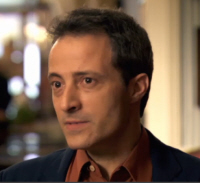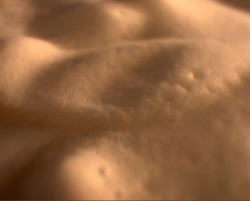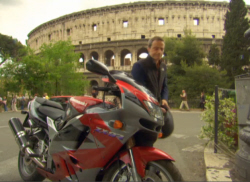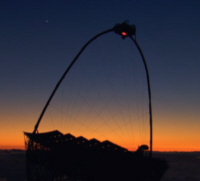Ultimate Limit
The Planck Length
Horizon - small Universe
As we look down in scale, things get increasingly cloudy. To stand a chance of seeing strings, we'd need a particle acceleratora million, million
tames bigger than the LHC. Is this, then, the end of the line for the explorers searching the smallest thing in the universe?
It turns out there could well be a bottom of the rabbit hole – ultimate limit of how small we can go. And there may be a way to reach this ultimate
destination – it's just a rather roundabout route to get there.

Dr Giovanni Amelino-Camelia
Dr Giovanni Amelino-Camelia is a theoretical physicist, who 12 years ago came up with an idea that could lead us to the ultimate destination at
the bottom of the rabbit hole. An idea that may lead us to question the very fabric of the universe – the dimensions of space and one of time,
known as space-time.
Giovannii Amelino-Camelia of the Saplenza University of Rome "Space-time to an ordinary person is space-time. What is space-time? There is no answer.
To us, space-time is, very tricky."
If we have any notion of space time, it is that it is smooth. We can move smoothly from one cafe to another, we can be reasonably sure how long a
journey will take. But maybe not if you get small enough. The ultimate small destination is known as the Planck length. It is the theoretical limit
of how small anything can possibly be.

Cappuccino Foam
Giovanni Amelino-Camelia "Some speculate that this could be the ultimate level. I mean, this could be where the laws of nature are fundamentally written."
But to get to the Planck length, you have to look a hundred, million, billion times smaller than a quark. At this tiniest of scales, we may find
answers not just about the smallest lump of stuff, but about the very nature of space and time in which all the stuff sits.
Giovanni Amelino-Camelia "What could be conceptually more fascinating than learning about the structure of space time? But our current theories
with all their limitations suggest that at this Planck scale that we're talking about, we should expect space time to, to be not smooth as we
presently imagine but more like, well, more like the foam of a cappuccino and actually perhaps then, in the violently dynamical way."
The Planck length is where the rules of the large and the rules of the small collide in a heady brew called quantum gravity. It's a seething
tempest of space and time known as space-time foam, where the very fabric of space and time twist and turn in every direction. It is where the
two great pillars of modern physics, general relativity and quantum mechanics, may finally be reconciled. If we could understand what is
happening down here, you'd end up with a theory of everything.

Giovanni in Rome
Giovanni Amelino-Camelia "We are really far, far away from, from this realm, and yet some of the most conceptually striking questions about
what, how is the universe made, what are its basic rules, appear to reside in this distant scale. So, at one side, we have this feeling of not
having any access to it, and yet it appears to be the place where most of the answers we are seeking are somehow hidden."
All roads in physics lead to the Planck length. But until recently, no-one had a clue how we would ever know anything about it. It was a problem
Giovanni was determined to solve, seeking inspiration and reassurance in the cafes of Rome.
Giovanni "I never understood what triggers an idea. And it's kind of reassuring to be reminded that all this is all about small – important,
conceptually important, but small – I'm still here, the Coliseum is still there. When you're stuck chasing a certain answer, you often discover
that all it took to find the answer was to look at the same problem from a different angle."
12 years ago, Giovanni had a flash of inspiration that we could reach the unreachable.
Giovanni "Over the last decade or so, what we started to figure out is that it is possible to get indirect information on the Planck
scale. We cannot build a microscope that shows us, shows us the structure of space time at the Planck scale, but we can get indirect
evidence about the Planck scale structure of space time is made."
Any Explorer will tell you that if the way ahead is blocked, you have to set off in a new direction. Instead of trying to look directly
down at the smallest scale, the idea is to look up at the very biggest scale possible – the entire universe.
It's an idea that is now reality… And a trick that is now being performed by the MAGIC telescope. The idea is to use the vastness of the universe
as a giant magnifying glass.



